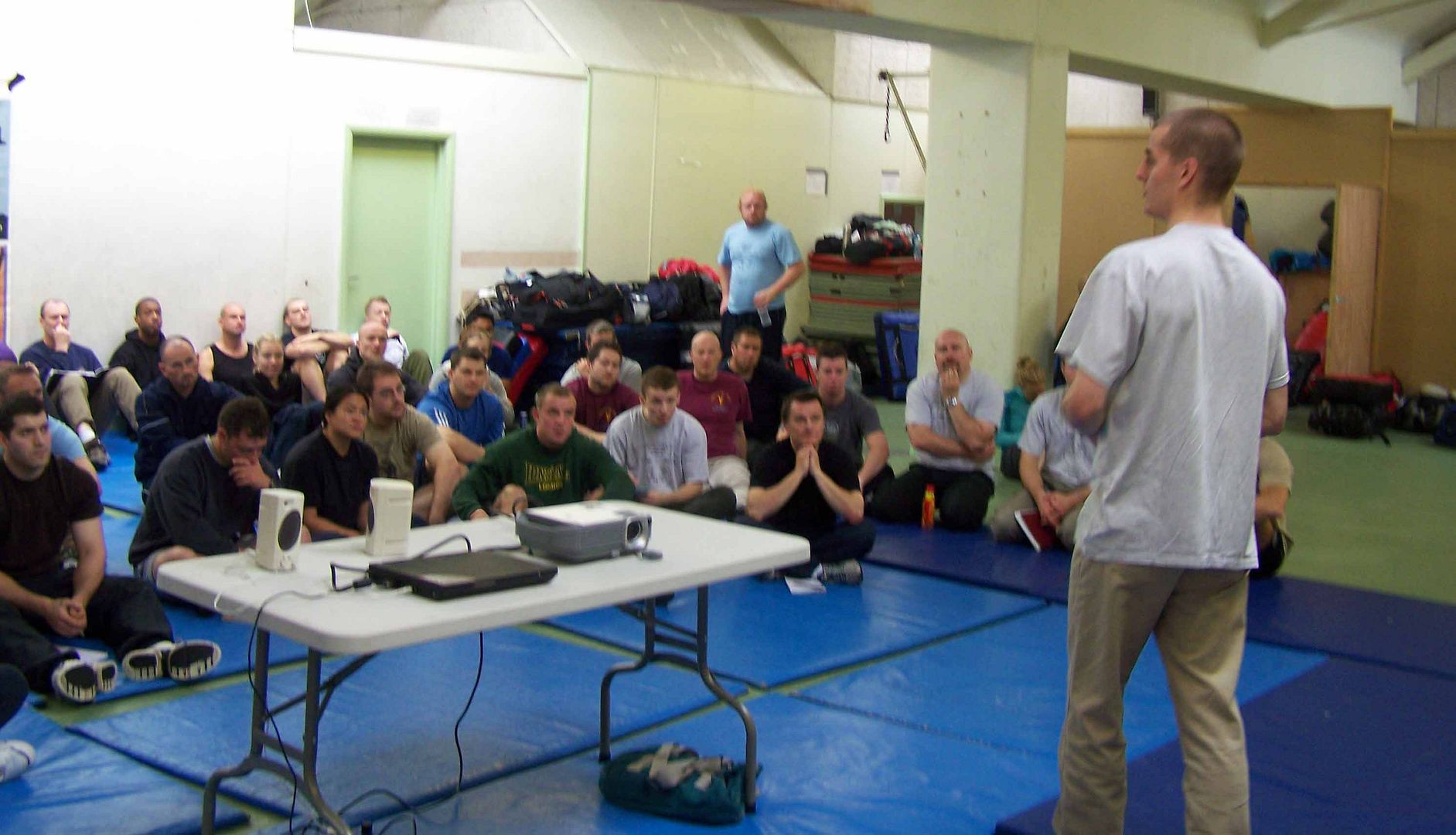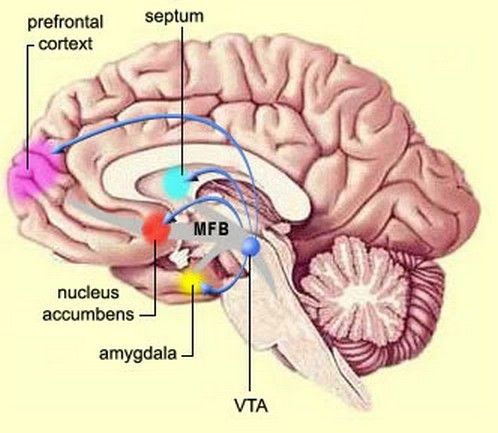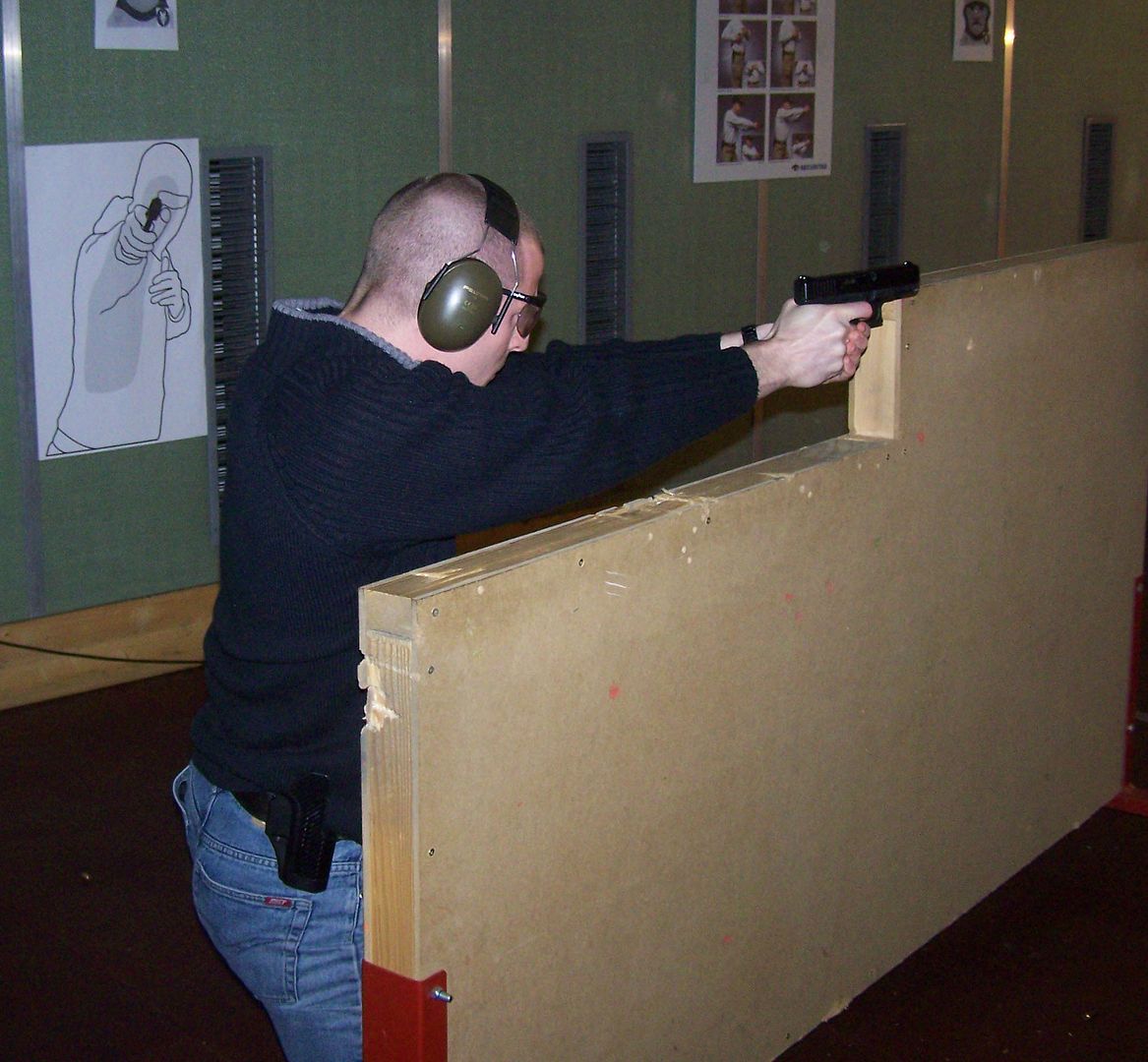Chemical Combat
By
Peter [Slackbladder] Morgan
[The Slackster presenting this topic at the 2007 International Seminar]
An overview of substances and their effects, directly pertaining to the Combatives practitioner.
A brief history of drugsOn January 18th 1887, a twenty-six year old Romanian chemist Lazar Edeleanu working in the University of Berlin created a substance he named "phenylisopropylamine". This substance was promptly shelved until pharmocological eggheads could find something useful to do with it. In 1893, the revered Japanese pharmacist Nagayoshi Nagai further manipulated ephedrine into methamphetamine. This was promptly snapped up by the Japanese government who took note of its stimulant properties.
As World War II broke out, the marketed form of amphetamine, popularly known as 'Benzedrine' was employed as a "stay awake" drug enabling Allied soldiers, spies and other persons in high pressure occupations to remain fit for duty with reduced dependency on sleep. The Japanese and Germans issued their military personnel with methamphetamine, and was faced with the subsequent mass addiction problem in post-war years.
Cocaine was first extracted from cocoa leaves in 1860 by gent named Albert Niemann. Cocaine was swiftly adopted by pharmaceutical companies who marketed it as a wonder drug during the 1860-70s.
Opium has long been established as a recreational substance, but in 1874 the application of industrial chemistry developed morphine. In 1898 the pharmaceutical company Bayer launched a cough medicine for children that also cured morphine addiction. It was called Heroin.
PCP was developed as an anaesthetic during World War One, but rejected because of the problems that would arise post-operation. Ketamine has since been adopted in its wake.

LSD is a by-product of rotting rye. Synthesised and researched as a possible cure for migraines by Sandoz Laboratories. It was hailed as a psychiatric cure-all and was given to mental health patients in an effort to cure them. It was also tested by the military forces of various nations as a potential truth serum.
Cannabis has been used as recreation for millennia, owing to its organic origin.
Enough of the history...how does it affect us?
The ProblemChemically enhanced competition makes life difficult for the clean-living. Just ask Olympic athletes or a Tour de France cyclist. Those who add industrial chemistry to their lifestyle and training typically enjoy enhanced strength, endurance and speed. To athletes, this means that the druggies enjoy a raft of gold medals and records, while those with a purer diet languish further down the league table.
We, however, are not in the business of winning medals or setting records. We just want to win a FIGHT, where losing may cost us everything. The bad guys are taking drugs too, and this has changed the field of criminal assault just as it has changed cycle races and weightlifting.
After-action-reports from police and security personnel have alerted us to the rising number of assaults by criminals acting under substantial chemical assistance. Feats of strength and endurance have been described that would shame a professional athlete. Pain tolerance has been recorded that would have been disregarded had it not been for the multitude of witnesses. The nightmare opponent is fast becoming far less of a black swan than we may like to think. The advent of industrially manufactured stimulants has brought with it a criminal who feels no pain, possesses the strength of ten men and bottomless reservoirs of energy. Homicidally enraged persons of this type are notoriously difficult to kill with firearms, so the citizen who is posed with solving this problem with his bare hands faces a struggle larger by several orders of magnitude.
It is easy to make a simple connection between the two and state that drug X (e.g. PCP) causes superhuman powers. This is wrong.
The Power Behind SuperpowersDrugs do not bequeath the subject with superpowers. If they did, the military would be spiking every item in every soldier's ration pack with the drug in question. Since the military is not in the practice of widespread use of stimulants beyond caffeine, we can assume this is the case (A drug marketed under the name 'Modafinil' has reportedly been used by soldiers and pilots to maintain alertness for extended durations of time. Whether this is issued equipment is unclear).
The short answer is that many stimulant drugs cause psychosis. Psychosis is defined as a "loss of contact with reality". There are many roads to psychosis, not all of them drug related. Mental illness sometimes results in it, as occasionally does childbirth. Profound similarities have been noted between schizophrenic psychosis and the postictal psychosis that epileptics may suffer after a grand mal seizure.
For the unfortunate subject, "loss of contact with reality" could well be translated into "contact with nightmares beyond imagination". Stimulant drugs (notably cocaine, cannabis, methamphetamine and PCP) incur changes to the amygdala. The amygdala is the threat-sensing portion of the brain that continuously monitors for danger twenty-four hours a day. It is a conduit through which all sensory data must pass. Put simply, this almond-sized piece of grey tissue is the source of fear and counter-measures to danger.
I have not yet encountered research that links paranoia and damage to the amygdala, but I will not be shocked when it surfaces.
Regardless of the neurological processes involved, a state of psychosis will cause the subject becomes so angry and/or afraid that the Body Alarm Reaction is activated in its entirety.
This is significant.
The human body is a fundamentally lazy organism. It does just enough to get the job done and little else. The capabilities of the human organism are something else entirely. The body is very much led by the mind when it comes to the field of performance parameters. Beliefs regarding capability and limits are very real limiters of human performance. The French Foreign Legion, way back in its history, enforced a policy of "March or die". Legionnaires were required to march long distances. Persons who decided they could no longer march were forced to re-evaluate their capabilities by the NCO in charge who would hold a firearm to the head of the subject and explain in no uncertain terms that their choices in the immediate future were limited to walking or dying a violent death. Not surprisingly, many Legionnaires tapped new sources of pedestrian energy and walked a good deal further without complaining,
Access to the emergency reserves of the human body are typically punitive. The reason that the average human lives at approximately 20% of his maximum is much the same as a car engine cannot be driven at maximum revolutions all the time. Let us examine strength...
STRENGTHStrength, in the "single-rep-max-effort" sense, is a function of the nervous system, not the musculo-skeletal system. A muscle is constructed of long, thin cells (named fibres) arranged together like strands of horse hair on a violin bow. Upon the order to exert effort, the nervous system will recruit a percentage of muscle fibres to exert the effort. In the ordinary office worker, 20% muscle fibre recruitment is typical. Athletes, in full time training, can raise this percentage by up to four times, perhaps reaching 80% recruitment. Full blown psychosis will raise this figure to 100% - literally every drop of potential is squeezed from the body by the panicking brain.
What the athletes have done in training to achieve this potential is prepare the body for the shock of full-bore effort. Just as you cannot connect a V12 engine to a child's pram and expect the flimsy chassis to handle the power without buckling or shattering, the human body isn't built to lift insane weights without preparation. Bone density must be adequate for the task; a large muscle exerting maximum strength is more than capable of breaking bones to which it is attached. Connective tissue must also be developed if the muscle is to remain attached to the bone in the first place.
We have all encountered the urban legends of the elderly lady lifting a car off her grandchild following a accident. What is not commonly communicated is the collapsed vertebra and hernia that results from such exertion.
PAINPain is a slightly different animal. Pain is a truly massive topic and occupies a substantial amount of medical literature. This is one of the few areas where we can point to a drug and state categorically that "This drug causes immunity to pain". PCP interacts with glutamate, a neuroreceptor intimately involved with pain. This interaction is supported by empirical evidence of PCP users damaging themselves in radical ways without distress.
Absence of PCP does not necessarily infer that the subject will experience pain, however.
The brain appears to manage pain very well in appropriate circumstances. During his time in Africa, the Victorian explorer David Livingston shot a lion, which promptly mauled him...
"Growling horribly close to my ear, he shook me as a terrier dog does a rat. The shock produced a stupor similar to that which seems to be felt by a mouse after the first shake of the cat. It caused a sort of dreaminess, in which there was no sense of pain nor feeling of terror, though quite conscious of all that was happening. It was like what patients partially under the influence of chloroform describe, who see all the operation, but feel not the knife. This singular condition was not the result of any mental process. The shake annihilated fear, and allowed no sense of horror in looking round at the beast. This peculiar state is probably produced in all animals killed by the carnivore, and if so, is a merciful provision by our benevolent Creator for lessening the pain of death."
It seems that in circumstances of mortal peril, the pain response is switched off altogether. The mechanism exists, so the trigger that activates it is there to be manipulated in psychosis.
Psychosis is not a typically useful state. True, you achieve preternatural toughness, but this is at the expense of the rational mind. The reason that the military does not induce psychosis in its front-line troops is that they are just as likely to kill one another as they are to kill the enemy.
Tactical use of drugs by the bad guys is not yet a common trend for this reason, but it would be foolhardy to expect this to remain the status quo. The decidedly amateur terrorists that attacked Glasgow airport were doctors who had procured morphine and injected it into themselves immediately prior to the attack. The flaming figures battling with police and passers-by were fuelled not by religious fervour, but by the poppy plant.
 [Terrorist on fire]
[Terrorist on fire]++++
FOR THE COMBATIVES PRACTITIONER
Health ImplicationsVarious aspects of the lifestyle of many drug users has resulted in health specific problems that are best addressed by way of prevention rather than cure.

Sexually transmitted infections are of particular note, as the pleasure seeking areas of the brain (notably the Ventral Tegmental Area and the Nucleus Accumbens) that drive the host to seek out pleasurable behaviours such as eating, drinking and sex, are very much "lit up" by stimulant drugs. There is increased incidence of sexually transmitted infections among habitual drug users, of which Hepatitis B, Hepatitis C and HIV are of special concern. Needle sharing remains one of the surer ways to gain these nasty diseases, a habit particularly prevalent among steroid abusers and IV drug users.
Hepatitis is an illness which attacks the liver and possibly cause liver failure. It is notoriously robust when outside of a host. Contaminated blood can be spilt onto a surface, and after fourteen days, still present a risk of infection. Hepatitis B is particularly communicable in this regard.
A vaccine exists for Hepatitis B, and I strongly recommend that you make an appointment with your GP to get yourself inoculated. A series of three injections is required, spanning six months. After that, a booster every five years is required (note: in event of a possible exposure, you'll receive a booster regardless). Be aware that you should inform your insurer of your Hep B vaccination, as your life/health insurance policy will have to be amended, possibly with a slightly higher premium due to the view that anyone who volunteers for a Hep B vaccine is living a high risk lifestyle.
No vaccine yet exists for Hepatitis C or HIV, though medical science is inexorably grinding its way towards a solution.
The human bite is a nasty thing. Bites can turn gangrenous, and depending how long you wait before going to the hospital, could lead to amputation or death. Red lines under the skin leading from the wound are a very late indicator of infection and should be treated immediately in A&E. Bottom line, if you have been bitten, visit your local Accident and Emergency. Transmission of Hepatitis or HIV via a bite are unlikely. That said, in the throes of a violent altercation, a split lip, dislodged tooth or any other injury to the mouth may result in a blood filled mouth. A bite from such a mouth that punctures your skin may lead to blood-to-blood contact, with subsequent risk of infection from Hepatitis and/or HIV.
In the event of a blood-to-blood contact, particularly an encounter where an edged weapon is present and one or more parties have been wounded, you should seek professional medical assistance immediately, regardless of whether or not you have sustained a 'serious' injury. As few as fifty HIV virus particles transmitted can be sufficient to commence seroconversion and subsequent infection. You can limit the likelihood of infection by taking a course of retroviral drugs as soon as possible after exposure. Retroviral therapy is an ever-changing field, so the only solid advice to give is to seek professional medical assistance as a matter of priority. Rather like encounters with poisonous fauna, it is immeasurably useful to have the miscreant available for testing. A few simple tests can confirm the presence or absence of many diseases and may well save you the cost and sheer ordeal of retroviral therapy.
Implications on the combative syllabusNeurology is still a science very much in its infancy; so much of what we know about the effects on the brain is still derived from empirical sources. Stimulants appear to drastically reduce the time taken to "reboot" to consciousness following a knock out blow. This is not to say that strikes to the head are now unreliable, but the window of sleep time that the bad guy may endure is now shortened. Similarly so for unconsciousness derived from chokes or strangles. Not only will the knock out be radically shortened, but the bad guy appears to be "on the same page" waking up as he was when he went to sleep - the moment he wakes up, he may become violent right away.
This means we should be rehearsing our post-incident procedure to effect a speedy exit. At best, rolling the bad guy on his front to prevent asphyxiation (and a possible charge of manslaughter/murder) followed by a swift egress.

Other possible areas of change may be an emphasis on immobilisation via structural damage. To draw comparisons with popular culture in cinema, the eponymous "Terminator", an unstoppable killing machine, only became manageable once its legs were removed. As bad as a badass might be, it is demonstrably difficult to chase a fleeing victim if your top speed is firmly set at "Crawl".
We shift our attention to the joints of the legs: the hip and pelvis, the knee and the ankle. By far and away the ankle remains a favoured target for the unarmed Good Guy. A collection of small bones and soft tissue, it is no difficult feat to stamp through the joint, shattering it into a useless mass below the tibia and fibia. Self manipulation of the ankle reveals which planes of movement are limited. Shearing force through the ankle, perpendicular to the direction of the metatarsal bones, reliably produces a broken ankle. Working to effect this technique from both non-contact distance, the clinch and ultimately stamping on the joints of the fallen opponent should become a staple of the syllabus in times ahead.
For the firearms user, targeting the pelvic girdle has an increased likelihood of robbing the bad guy of the ability to stand, run, or kick. Indeed, simply rendering a bad guy immobile does a lot to reduce the load on the visuo-spacial problem of multiple-opponents. A mortally wounded bad guy still moving with the pack has just as much a ramification on your positional calculus as the healthy bad guy. Reduce the problem and encourage a Zen-like stillness in your opponents by shooting them in the pelvis.
 [Slacky on the range in Switzerland]
[Slacky on the range in Switzerland]The natural alternative to the pelvis is the head, but the skill level required to reliably achieve head shots is well documented. The head is a frequently mobile target, while the pelvis retains a modicum of stability. A lesser consideration is the question of the backdrop to the shot. Shots to the pelvis are downward from the horizontal, with consequent limitations on the distance travelled by the projectile before it encounters the ground.
Pharmacology is by no means a dead science. New anaesthetics are in development, and as these directly concern themselves with consciousness and pain, they may well be the first indicator of a new wave of drugs to hold youth in rapture in the coming decades. Research and development has never stopped. Given the pace of neurological research, combined with new technologies in use by the enormously wealthy pharmaceutical companies, to say nothing of the formidable R&D resources of the drug overlords themselves, we can expect a continuing downward spiral.
In the (long) time it has taken me to compile my presentation notes into an essay, I encountered some fascinating sources of information.
Of particular note is this
Neuroscience podcast'Nature' is one of the premier science journals available globally, and information they publish is typically solid. The podcast is only 22 minutes long and targeted toward a generalist audience - you don't have to be a neuroscientist to understand what is being said. That in mind, I recommend you keep a notepad and some paper beside you as you listen so you can look up key words and terms whose meaning eludes you.
This month's podcast is an absolute gem. It contains information on recently developed local anaesthetics that nullify ONLY the pain response, while avoiding other nerve functions. Could be a big thing in battlefield first aid/surgery. Other topics include military application of neuroscience (specifically sleep and interrogation), interpretation of MRI results and the reactions of male and female mice to learning under stress. I heartily recommend it.
----------
To join a discussion on this article go to the forum thread
here